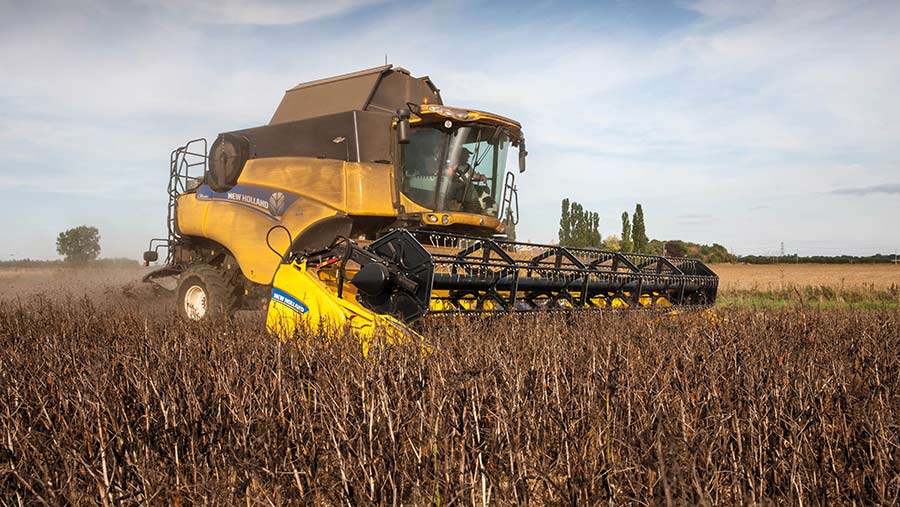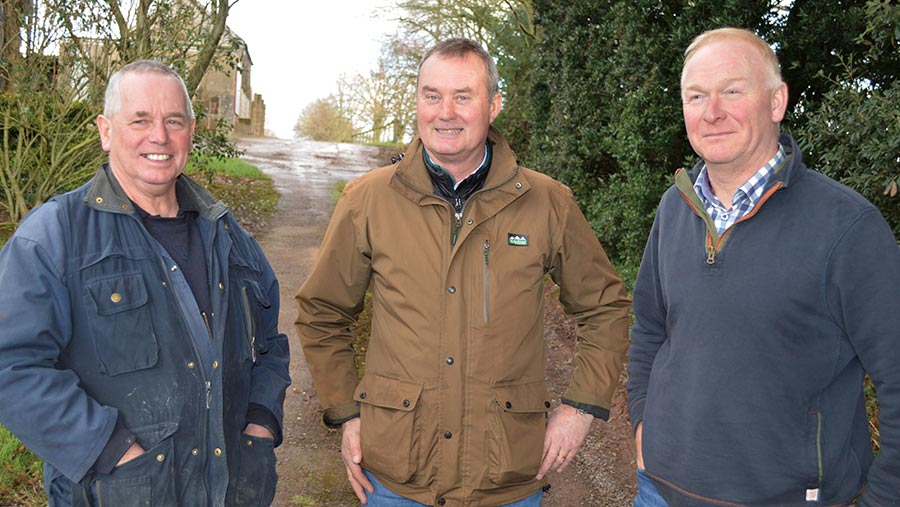Farmers join forces to grow high-yield low-cost spring beans
 © Tim Scrivener
© Tim Scrivener Spring beans are an excellent break crop for two Welsh growers who produce high yields with low growing costs, and thankfully with no need for bagged nitrogen fertiliser, which has more than doubled in price over recent months.
Yields are north of 5t/ha in this relatively dry corner of south-east Wales, harvest is done and dusted by mid-September and there is increased demand from local animal feed compounders looking to replace imported soya.
After ammonium nitrate fertiliser prices rocketed starting last summer, a substantial saving can be made from not having to apply any to the spring beans and then cutting back on nitrogen for a following winter wheat crop.
See also: Norfolk grower to double pea area after fertiliser price jump
Farm facts
Colin Phillips, Dairy Farm, Tregare, Raglan, Monmouthshire
Farming nearly 300ha, growing oilseed rape, winter wheat, winter barley, winter naked oats, spring beans and maize
Grassland for 40 sucker cows and 80-100 fattening cattle
Ian Williams, Llwyn-y-Gaer, Tregare, Raglan, Monmouthshire
Farming 132ha of all arable, growing oilseed rape, winter wheat, winter oats, spring beans and maize

Left to right: Colin Philips, Tim Seymour, Ian Williams © MAG/David Jones
High yields
Colin Phillips grows 20ha of spring beans with yields sometimes touching as high as 7t/ha, while this spring break crop fits well into Ian Williams’ search for low- or no-nitrogen crops for the future.
Mr Phillips is keen on beans as they are an excellent break crop and a good entry for a following crop of winter wheat, while giving a profit margin as good as or better than any other spring break crop.
“Spring beans give us the opportunity to grow more home-grown protein rather than use imported soya, which is especially important as there is more pressure to cut our carbon footprint,” says Mr Phillips.
Mr Williams says if nitrogen fertiliser prices stay high, he may have to look at more spring-sown crops, as some, like oats, need less nitrogen, and will also make more use of poultry litter from his 185,000 broilers.
“The poultry litter is a very valuable resource and will help when we look at low-nitrogen and no-nitrogen crops in the future,” he says.
Both neighbouring growers farm light sandy clay loam land midway between Abergavenny and Monmouth, with beans and maize being their only spring-sown crops, alongside autumn-sown oilseed rape, wheat, barley and oats.
Spring break crops
Tim Seymour, agronomist to both growers, says the area produces higher yields of spring beans than winter beans, and the pest pressure become lower in terms of bruchid beetle as soon as you cross the Severn Bridge into Wales.
Feed bean crops yielding more than 5t/ha and selling for £240/t, with variable costs of only £360-370/ha, bring in a gross margin of £800-900/ha, not matching a 10t/ha-plus crop of feed wheat but much better than many alternatives.
This area of south-east Wales is relatively dry with an annual rainfall of only 850mm, as it is in a rain shadow behind the Welsh mountains, and the area tends to suit spring beans rather than winter beans which can grow excessively tall.
“Beans are the best spring-sown break crop in the area and leave fabulous soil conditions for a following crop of wheat,” says Mr Seymour, who works for the advisory group Agrii.
The bean crops leave behind about 50kg/ha of nitrogen in the seed-bed of a following winter wheat crop – which at current nitrogen prices is worth about £90/ha.
That means winter wheat varieties such as Graham and Extase received only 170kg/ha of nitrogen in the spring rather than a more normal 220kg/ha.
Ammonium nitrate fertiliser prices have largely doubled in price since June last year to well over £600/t, reflecting high energy prices and shortages when UK nitrogen fertiliser plants closed down in the summer.
Long crop rotation
Both growers have five- to six-year crop rotation, with spring beans often following winter wheat and preceding the crop, and they leave wheat stubbles over the winter ahead of spring beans.
They say a good wide rotation is key when growing oilseed rape and beans. They gave up growing combine peas about 25 years ago as the crop was difficult to harvest, instead turning to spring beans.
Mr Phillips uses a tine-disc cultivator in the spring and then drills as soon as possible afterwards with his power harrow-drill combination, while Mr Williams prefers spring ploughing one week before drilling and then he is in with his own power harrow-drill combo, and both use a roller to keep stones well pressed down.
Both favour the power harrow-drilling combination as they don’t want to be caught out by the weather, as sudden rain can make seed-bed preparation very difficult.
They are both using the variety Fuego at a seed rate to produce 45-50 plants/sq m, drilling at a depth of 45-50mm. Drilling ideally is aimed for mid- to late March.
“We are looking to drill as deep as possible to hit moisture as the seed can germinate within 2-3 days, and also deep enough not to leave the crop vulnerable to a pre-emergence herbicide,” says Mr Seymour.
Spray programmes
The pre-emergence Nirvana (imazamox + pendimethalin) is used within 24 hours of drilling to give good control of brassica weeds and volunteer oilseed rape, and they try to avoid any post-emergence treatments such as bentazone to keep costs down.
Two fungicides are used, the first at the beginning of flowering in late May/early June when Signum (SDHI boscalid + strobilurin pyraclostrobin) is used to control chocolate spot and rust, and then a second spray three weeks later of Amistar (strobilurin azoxystrobin) + azole tebuconazole.
Mr Seymour is looking at Elatus (SDHI benzovindiflupyr + azole prothioconazole) as it is now cleared for use in beans and has good activity on rust, while both growers try to avoid insecticides against bruchid beetle.
“Rust is a problem in beans here. It is not if you get rust, it is when you get rust,” says Mr Phillips
Soils tend to be short of boron and molybdenum and so these micronutrients are added to the fungicide sprays, with sulphur also added, while phosphite is used to encourage the crops to grow away from any bean weevil infestation or downy mildew infection.
Crops are direct combined without the need for glyphosate between 28 August and 15 September. Both growers aim for the human consumption market for a £10-15/t premium, but do not often meet the required standard.
In the future, they are unlikely to increase their bean areas due to rotation restrictions but are looking at a switch to a higher-yield variety such as Lynx, which on the Processors and Growers Research Organisation (PGRO) descriptive list yields 106% against Fuego on a lowly 95%.
Working together
The two Welsh growers have been co-ordinating on sharing machinery for two decades to cut cost across their two farms, with a focus on combines and sprayers.
The arrangement kicked off 20 years ago when Mr Williams was selling off his dairy cows and both were looking to update their combines.
They set up a separate company and bought one combine to replace their two individual ones. They pay the company a charge based on how much they use the combine to cut crops. All their fields are within a four-mile radius.
The arrangement works well as Mr Phillips is often keen to start cutting early, while Mr Williams is happy to hold back.
The next step was a self-propelled 24m Househam sprayer which is used under the same sharing arrangement.
Their latest combine is a 22ft-header New Holland, with the straw sold by auction and fetching a good demand from Welsh livestock farmers willing to come and bale.
Beans on the rise
The UK bean area is set move slightly higher this spring with a bigger increase set for the 2023 harvest, as higher nitrogen fertiliser prices really start to have an impact.
Rebecca Gibson, pulse product manager at Agrii, says there is an almost “perfect storm” for pulses due to higher nitrogen fertiliser prices, a demand for more home-grown protein crops and growers’ search for alternative break crops.
“We expect the bean area to edge up this spring and then see a much bigger rise next year as the fertiliser price rises really kick in,” she says.
Many growers bought nitrogen early before the summer 2021 price leap, so will be insulated for this season, but will have to buy at the higher price for next year.
Top-selling spring bean varieties this season are likely to be the high-yielding Lynx and also Vertigo, favoured by many for its consistency and large seed size, while for next season Viper is set to become more popular due to its good agronomic characteristics, she adds.
The UK bean area rose 3.3% to 187,000ha for harvest 2021, which was only a small rise from 181,000ha in 2020, which in turn was a big jump from 137,000ha in 2019. Traders estimate that about 60-65% of national bean crop is spring-sown and the rest autumn-sown.

